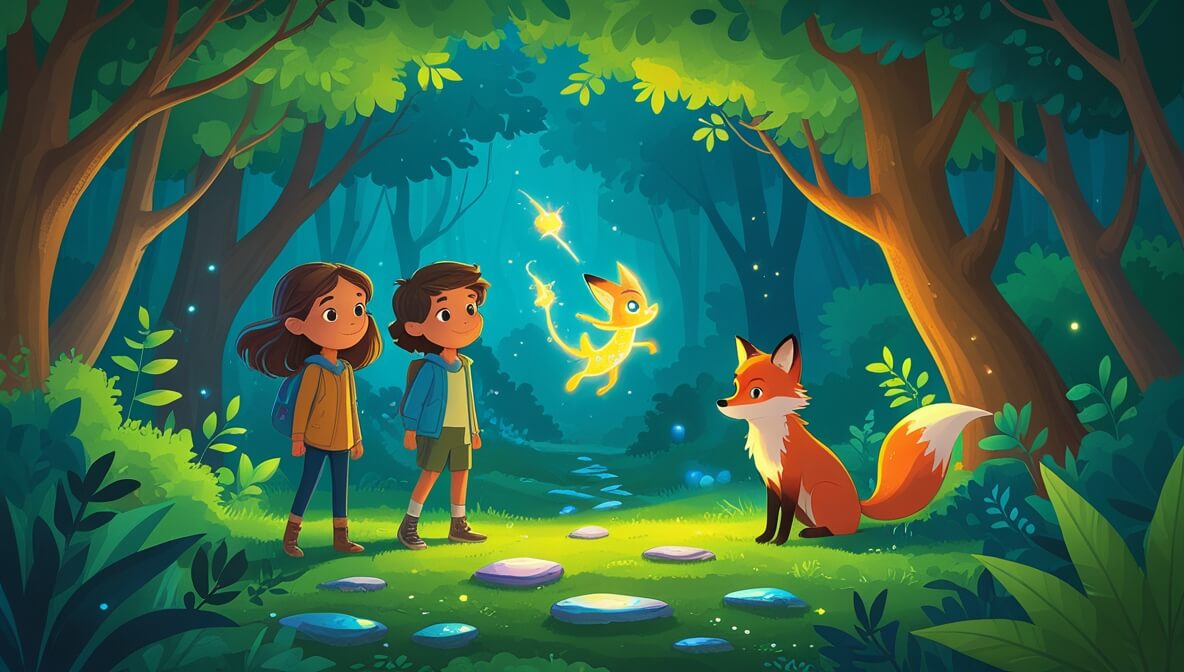In a kingdom where dreams and stars intertwined, Princess Niamara discovers a hidden garden with magical secrets. With her loyal friend Finnick, she embarks on an adventure to restore a forgotten joy to their land.
Age Recommendation
3 – 12 years
Characters
Characters:
- Princess Niamara (A curious and adventurous princess who loves exploring)
- Finnick (A brave and clever stable boy who is Princess Niamara’s best friend)
- Queen Amara (A kind and wise queen who cherishes her daughter deeply)
- The Enchanted Nightingale (A magical creature with the power to bring songs to life)
Story
Once upon a time, in the shimmering kingdom of Lumina, there was a young princess named Niamara. She lived in a magnificent castle with her mother, Queen Amara, who ruled with a heart full of kindness. One starry night, while gazing out of her tower window, Princess Niamara noticed a soft, glowing light far beyond the castle walls. Her heart filled with curiosity, she decided to **venture** into the mysterious glow.
The Garden of Dreams
The next morning, Niamara shared her plan with her best friend, Finnick. Finnick, always up for an adventure, agreed to accompany her. Together, they set out on horseback, following the trail of twinkling lights. The path led them to an ancient forest, where they discovered an overgrown gate. Beyond the gate lay the **Garden of Dreams**, a forgotten place filled with vibrant flowers and a gentle, singing breeze.
The Enchanted Nightingale
As they wandered deeper into the garden, a melodious song echoed through the trees. Following the sound, they found a beautiful **enchanted nightingale** perched on a silver branch. The nightingale sang of a time when the garden was alive with laughter and joy, but an old spell had silenced it. Niamara and Finnick knew they had to break the spell to restore the garden’s magic.
The Secret of the Silver Stream
The nightingale revealed that the secret lay in the silver stream that flowed through the garden. If they could find the ancient **spellbook** hidden at the stream’s source, they could break the curse. With determination, Niamara and Finnick followed the stream, overcoming tangled vines and tricky trails.
The Spellbook’s Verse
At last, they reached the stream’s source, where a **shimmering spellbook** lay upon a stone pedestal. Opening it, they found a verse that spoke of love, courage, and dreams. Together, they recited the spell aloud, their voices blending with the nightingale’s song. As the final words were spoken, the garden blossomed with life, and the nightingale sang louder than ever before.
Restoring Joy
With the garden’s magic restored, Niamara and Finnick returned to the castle, bringing with them bouquets of enchanted flowers. The kingdom of Lumina was filled with joy, and Queen Amara praised them for their bravery and heart. The Garden of Dreams became a place of wonder for all to enjoy, and the nightingale’s song was never silenced again.
The end.
Moral of the Story
The story teaches that **courage and friendship** can overcome any challenge. By working together and believing in their dreams, Princess Niamara and Finnick restored joy to their kingdom and discovered the power of perseverance.
Questions to Think About
- Why do you think Princess Niamara wanted to explore the glowing light?
- How did Finnick help Princess Niamara on their adventure?
- What was special about the Garden of Dreams?
- Why was the nightingale’s song important to the kingdom?
- How did the spellbook help them break the curse?
Do You Know
- Nightingales are known for their beautiful and powerful songs, which they sing mostly at night.
- In many cultures, gardens are symbols of peace and harmony, often representing the beauty of nature.
Word Explorer
- Venture: To go on a journey or adventure.
- Enchanted: Filled with magic or delight.
- Perseverance: Continuing to try, even when things are difficult.
Emotions in the Story
- Curiosity: When Princess Niamara saw the glowing light and wanted to explore.
- Bravery: When Finnick and Niamara set out to find the spellbook and break the curse.
- Joy: When they restored the garden’s magic and the kingdom felt happiness again.
Color Your Scene
Imagine Princess Niamara and Finnick standing by the silver stream, holding the shimmering spellbook as the nightingale sings. Draw this magical moment, using colors like silver for the stream, vibrant greens for the garden, and golden hues for the enchanted nightingale.
Parents’ Corner
This story is a wonderful opportunity to discuss with your child about:
Curiosity and Discovery: Encourage your child to explore their surroundings and ask questions, just like Princess Niamara.
Friendship: Talk about how Finnick and Niamara supported each other, showing the importance of teamwork.
Overcoming Challenges: Discuss how the characters faced obstacles and succeeded, teaching resilience.
The Beauty of Nature: Use the Garden of Dreams as a way to discuss the importance of caring for our environment and appreciating its wonders.











